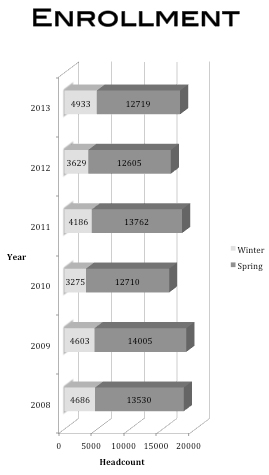The increase in class sections over the last year have kept Citrus College students coming back for more.
Enrollment rates have continued to grow in the last couple of years and with Citrus reaching 100.01 percent of seat capacity, this spring 2014 semester is no different.
Class sections were cut due to the recession in 2008. Since then Citrus has been working towards restoring those enrollment numbers.
Citrus College receives funding from the state of California according to the number of full-time equivalent students (FTES).
One FTES takes 15 units in the fall and spring semesters of one fiscal year.
For the 2008-09 semester Citrus had 11,928 funded FTES. The 2012-13 semester had 10,668 funded FTES and Citrus has continued to restore those numbers in the 2013-14 semesters to 10,905 funded FTES.
The money provided by the state for FTES directly affects the number of sections made available to students.
“State budget cuts from 2008 – 2012 reduced the number of course offerings available from Citrus College and other community colleges creating a pent up demand for classes,” said Arvid Spor, vice president of student services and interim vice president of academic affairs.
With the passage of Prop 30 in November 2012, which called for a temporary tax increase, there is more funding made available for public education. The extra funding from the state is what has made it possible for Citrus to add more than 200 sections in the past year.
For the winter 2014 semester there were 202 sections made available to students, with a hike of 1,151 enrollments from winter 2013 to winter 2014. The target number of FTES was 734 and that number was surpassed by 121.
“I am very pleased with the successful winter session and being able to support the education goals of our students,” said Geraldine M. Perri, Ph. D., superintendent/president of Citrus College.
Each class offered has a cap on the number of students allowed to enroll in the course. At the professor’s discretion the cap may be exceeded. Students who are in the percentage over the cap limit are called unfunded FTES.
Citrus is paid $4,564.83 per FTES, and the unfunded FTES are essentially taught for free.
“At the end of the year, after a certain period of time, the state adds up all the FTES that they pay all the different 72 districts for, and if there’s money still left on the table that’s been budgeted . . . they divvy it up and they start paying the unfunded FTES for districts,” said Samuel Lee, dean of language arts and enrollment management.
This spring semester has 33,696 enrollments, which is 630 less than spring 2013. The fill rate percentages are higher than the previous year but the FTES numbers are lower. The target FTES was 4,554 and by census day Citrus came in 22 below its target.
“We think we’re going to be entering in the next five to seven years a period when it’s going to be harder to find the students,” Lee said.
Neighboring community colleges, such as Pasadena City College and Mount San Antonio College, are facing the same struggles.
“We think we are going be entering a period where all our peer colleges are trying to grow because the state has enough money to grow, but now there’s not quite enough students to fill all the classes,” Lee said. “So now you’re scrambling to try and generate your FTES cap because you still need to match it.”
To accommodate the increasing enrollment administrators are planning on adding a few more sections to the upcoming semesters. This will help students get into classes that they need as well as help the college to reach its FTES goals.



